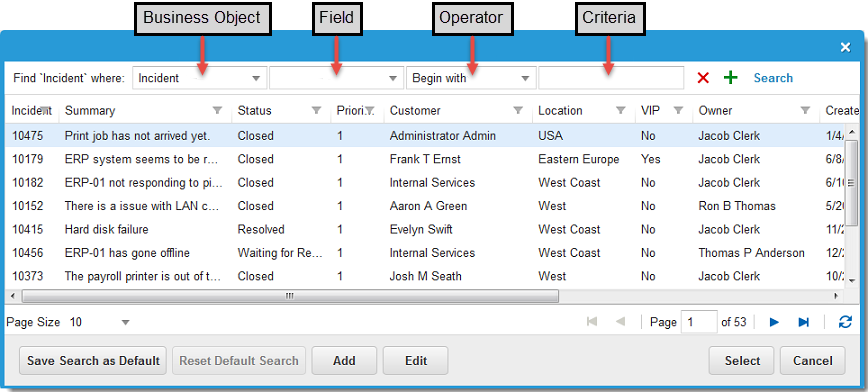Using Record Search
Often with a form, you can link your record to another record. For example, you can link a configuration item to a change or problem.
You can also search records using a text search. See About Simple Text Search and About Type Ahead Search.
This relationship between the two records creates a status association as well as a cross-reference. For example:
•When an incident is linked to a problem, the incident status changes to waiting for resolution. If unlinked, the status reverts to the previous state. When the problem is closed, all linked incidents are resolved and the information is copied to the linked incidents and the affected customers are notified. If there is a workaround, notification is sent to the incident owner (such as the Service Desk Analyst), not the customers.
•When the problem to which an incident is linked is closed, all incidents linked to the problem are changed to resolved status.
To link one record to another:
1.Log in to Neurons for ITSM.
2.Open the record you want to link. For example, open a configuration item record from the CI workspace. The form appears with data in the fields.
3.Select a tab containing a link icon, then click the link icon  . The record search window appears.
. The record search window appears.
4.Enter the search criteria.
| Field | Description |
|---|---|
| Business Object | The business object to find. Select one from the drop-down list, such as incident, service agreement, or My Item. |
| Field | Optional. The field to search. Select from the drop-down list. If you do not select a field, all fields within the business object are searched. The available fields depend on the chosen business object. |
| Operator |
The operator to use. Choose an operator from the drop-down list.
Equal to: The value in Field matches the value in Criteria. Not Equal to: The value in Field does not match the value in Criteria. In List: The value in Field contains one or more of the values in Criteria. Not In List: The value in Field does not contain any of the values in Criteria. Begin with: The value in Field starts with the value in Criteria. Not Begin with: The value in Field does not start with the value in Criteria. Contains: The value in Field contains the string value in Criteria. Does Not Contain: The value in Field does not contain the string value in Criteria. Like (SQL format): The value in Field contains the string value in Criteria. Use SQL wildcards, such as %, to search. Not Like (SQL format): The value in Field does not contain the string value in Criteria. Use SQL wildcards, such as %, to search. Is Empty: Field does not contain any values. Is Not Empty: Field contains something (is not empty). Full text search: (Only available when the value in Field is full-text indexed) Performs a Microsoft SQL full-text search on the value in Field, using the "WHERE CONTAINS(field, text, ...)" syntax. Full text not search: (Only available when the value in Field is full-text indexed) Performs a Microsoft SQL full-text search on the value in Field, using the "WHERE NOT CONTAINS(field, text, ...)" syntax. |
| Criteria |
The value to search.
For a text value, enter the text. For a DateTime field, click the calendar picker. If the Operator is Equal to, enter $ to view a list of DateTime functions. If you have a validated field and the Operator is in List, choose the options from the drop-down list. You can select multiple options.
You can also enter an expression. For example, you can enter $(Prompt("Please Select Priority","Priority of IncidentPriority used in Incident",200,400)). |
If the values for the Field and the Criteria fields do not have the same data type (for example, if the value for Field is a Boolean and the value for Criteria is text), the application returns an error. If you created a saved search prior to Neurons for ITSM Release 2014.3, and that saved search included values with different data types, you get an error if you run the saved search in Neurons for ITSM Release 2014.3. If this happens, contact your administrator. The administrator must open the saved search and click Reset Default Search to reset the search. This button is only available to administrators.
Reset Default Search Button
5.Click the add icon  to add another search line and enter more criteria. Repeat as needed.
to add another search line and enter more criteria. Repeat as needed.
6.To remove a search line, click the delete icon  .
.
7.Click one of the following:
•Select: Add the item to your record.
•Save Search as Default: Automatically load your criteria into the record search window each time. This criteria appears throughout all objects.
•Reset Default Search: Remove your default criteria.
•Add: Create a new linked object record. For example, if you are linking an incident object, then a blank incident form appears. From here you can create a new incident record that is automatically linked to your parent record.
•Edit: Modify a selected record. For example, if you have selected incident 10424, you can modify the information in this record from here (assuming you have privileges).
•Cancel: Dismiss the window without linking the record.
8.Click Save.

